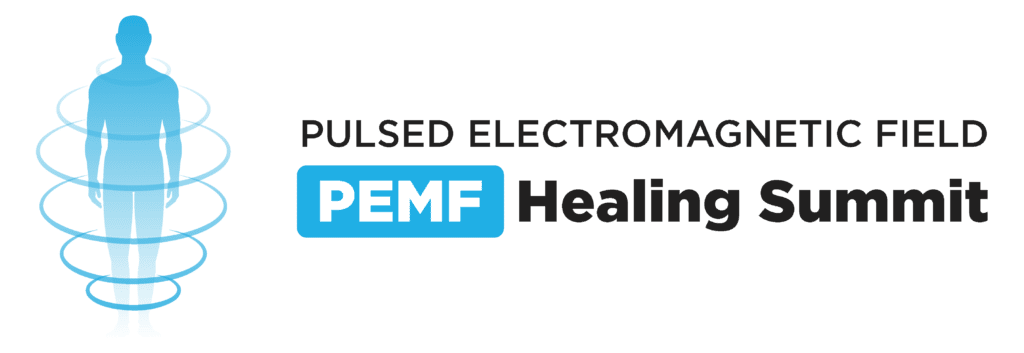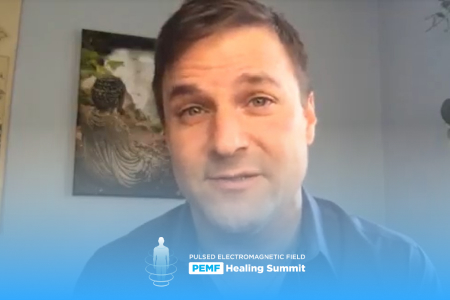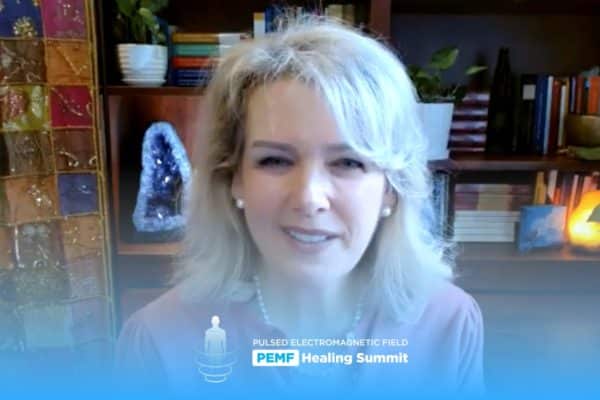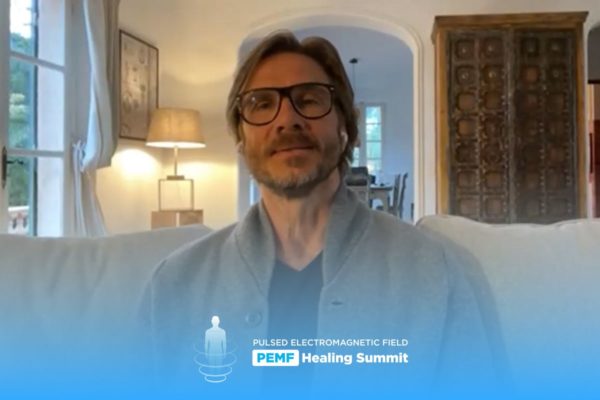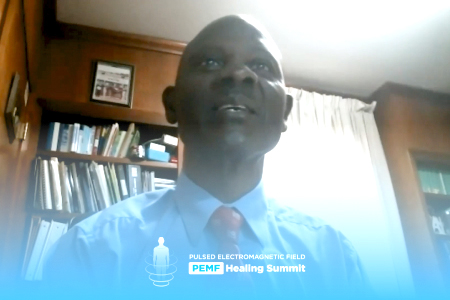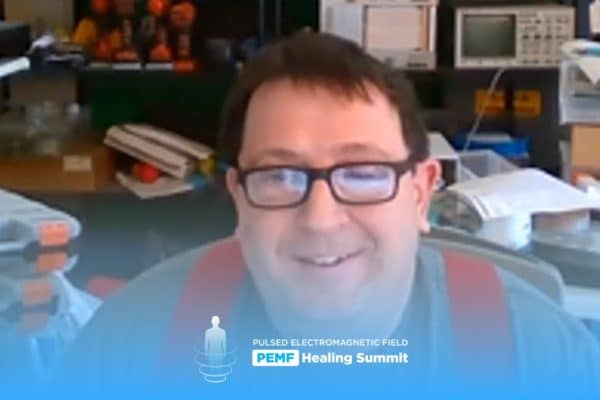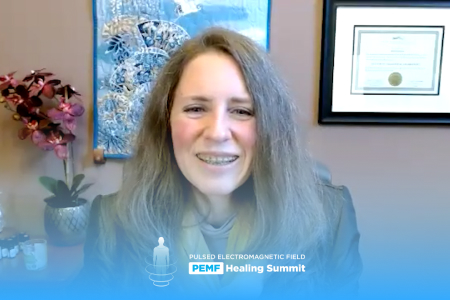Join the discussion below
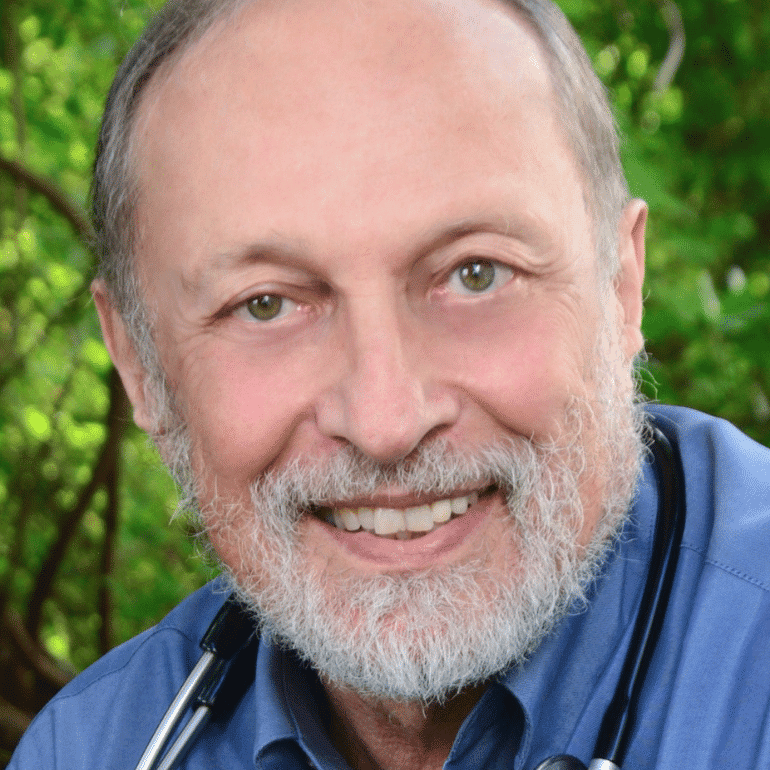
William Pawluk, MD, MSc, author of “Supercharge Your Health with PEMF therapy”, was recently a holistic doctor near Baltimore, MD. Previous academic positions at Johns Hopkins and University of Maryland. Training: acupuncture, homeopathy, hypnosis, energy medicine, nutrition and bodywork. Considered the foremost authority on the practical use of Pulsed Electromagnetic... Read More
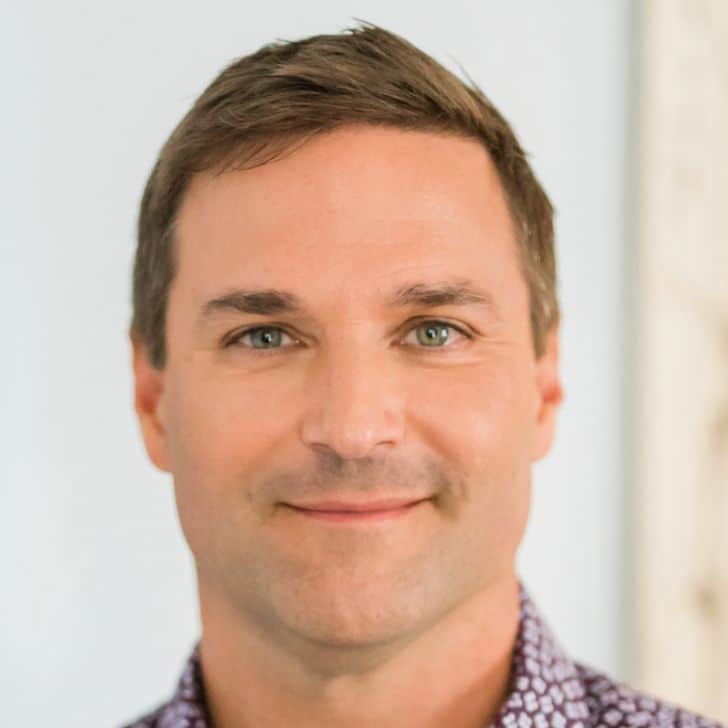
Gregory Eckel has spent the last 20 years developing and refining his unique approach to chronic neurological conditions. In addition to his experience in clinical practice using a combination of Naturopathic and Chinese Medicine, he has a deep personal connection with chronic neurological disease since his wife Sarieah passed of... Read More
- The development of the FAN-C approach to heal even severe brain degeneration.
- The FAN-C approach – Functional, Assessment, Nerve health, Cellular regeneration.
- Why the future of healthcare is in PEMF, frequency, sound and light. A comprehensive approach to brain healing.
- Enhancing the benefits of PEMF, LLLT, acupuncture, HBOT and other therapies.
- The future of brain regeneration
William Pawluk, M.D., MSc
Hi, this is Dr. Pawluk. I have a fascinating interview today with Dr. Greg Eckel. He is a specialist in one of my favorite areas and we’ll get into why that’s the case. And I think we both share the same passion for helping people with these kinds of problems. So Dr. Eckel specializes in neurodegeneration. So rather than me talking about that and what he does and how he got here, let’s ask Dr. Eckel to tell us his path, his journey.
Greg Eckel, N.D., LAc
Well, thanks for having me on. It’s a pleasure. I have been in medical practice for 21 years, came out of medical school in 2001 and had a general family practice here in Portland, Oregon. Wasn’t until four years ago that I really I got the School of Hard Knocks curriculum in neurodegeneration. My wife, Sarieah, started to develop rapidly progressing dementia. She was young, she was early forties and you think about, “Well, what could that be in a 42 year old woman?” And we were thinking, “Well, maybe it’s early menopause, maybe it’s hormonal changes, maybe it’s mold.” You know, we go after the low hanging fruit, maybe an infection. But rapidly progressing dementia in anyone is alarming and within three months, Sarieah wasn’t able to talk. It became very ominous on what is in the differential there and I had a lot of growing up to do during that period. We had blended our medical practices, she was a certified nurse, midwife nurse practitioner. We blended our families, her three kids, my two kids and we even had a maid named Alice just like “The Brady Bunch”. And it was just alarming. You get into that differential and there’s autoimmune conditions of the brain and the Creutzfeldt-Jakob disease, which is CJD. And I always knew Sarieah was one in a million, but unfortunately the brain experts agreed and they gave her the diagnosis of CJD, which only gets proven until they offer you a free brain biopsy at the end of that.
William Pawluk, M.D., MSc
I was gonna say brain biopsy, right?
Greg Eckel, N.D., LAc
Yeah. And, you know, I don’t wish that on anybody. I was uniquely positioned, loving husband and clinician, so I swung for the fence and I went digging deep with really her life on the line. And unfortunately I didn’t come up with therapies that helped her. However, the therapies that I did discover are helping thousands of people around the globe now. That’s how I really got into becoming a brain expert, is I talked to a lot of brain experts in particular for can we do anything for my wife? So, in such a weird way the whole process has ripped me open as a human being. It reinstated my faith in the oneness of all, it’s just life is not for the faint of heart. Let’s just say that. Going through it I knew that the medical system was broken, but to go through it with your wife’s life on the line, it’s really heartbreaking. Coming out of it I knew I didn’t want my suffering to be for not and so I really utilize that as a catalyst to put a flag in the earth and taking a stand for people and their brains, their brain health and neurodegeneration in particular, because I don’t know if you’ve seen, but it really gets overwhelming and quite depressing if you have a neurodegenerative condition, because there’ve been no major breakthroughs, right? I mean, for Parkinson’s disease we’re still using a drug that was sanctioned in 1974, carbidopa and levodopa. And I think that it’s time that we make some change for people and that’s what I codified. I created my fancy approach to brain regeneration. I kinda went into Parkinson’s disease because, as I said, CJD is very rare disorder, but in the research what I discovered was prions and prions are misfolded proteins. And in the first prionic textbook, which I have, which is not that old, you find, there’s beta-amyloid plaque, well there’s Alzheimer’s, alpha-synuclein, that’s Parkinson’s, there’s a whole of tau proteins. So there’s a bunch of different misfolded proteins in neurodegeneration that causes the symptoms of the brain central nervous system breaking down. And so I’m going after that and I like to say I’m a clinician’s clinician so I wanna use stuff that works. Came across frequencies and I’ve been saying, I believe light and sound frequencies are the future of medicine and boy, we really need them now more than ever.
William Pawluk, M.D., MSc
Let’s go back to prions. I call ’em prions. Some people call ’em prions, prions. Tomato, tomato, right?
Greg Eckel, N.D., LAc
That’s right, that’s right. Yeah.
William Pawluk, M.D., MSc
Well let’s tell everybody that prions are mad cow disease.
Greg Eckel, N.D., LAc
Yeah. So, well, not just that. So prions or prions in Creutzfeldt-Jakob disease is mad cow syndrome, right? So we’ve heard of that, but it’s also called scrappy in sheep. It’s called wasting syndrome in deer. So all of the animal species have misfolded proteins that is similar to mad cow. We’re more familiar with mad cow syndrome because of the tainted beef in the 80s coming out of England into Europe. You know, interestingly enough there wasn’t a spike or a considerable spike of Creutzfeldt-Jakob disease or prionic activity. The other thing when you start reading about prions they’re always called infectious prions, which is alarming, right? You can’t destroy these misfolded proteins. Heat won’t do it. I mean, it’s like very, very intense chemical preparations would do it. That’s not something that you put in the human body or in an animal body for that matter. So they’re misfolded proteins. So I think the trillion dollar question is why do proteins misfold? I have a couple hypothesis on that that we can talk about, but you also then look at other misfolded proteins. So Stanley Prusiner got the Nobel prize in 1987 for discovering these prions or misfolded proteins. They’re interesting cells in the body because they don’t have any cellular apparatus per se. And he was seeing these on the slide and of course with major breakthroughs, there’s much conjecture saying, “No, it’s a virus. You’re seeing something else that’s not there.” He really stuck to it and because of his work we now have this whole classification of diseases and why people aren’t really talking about them is we’re not finding a lot of substances to correct, to deactivate the prions and to eliminate them from the body.
And so I think they’re called infectious prions because they start once one cell misfolds from damage is really where I think it’s coming from. Traumas, unresolved traumas, it can even be ancestral traumas oddly enough, levels of toxicity chemicals in the environment. Those are the biggest runners of, I think, wide proteins. They get denatured, right? When you look at just naturally how do proteins denature, it’s usually from a couple of substances, temperatures, chemicals. I’ve put the trauma component in there because over the last four years, really deep dive into neurodegeneration and the folks that I’m seeing with dementia, Alzheimer’s, even the CJD there is a pattern for folks whether it’s conscious or unconscious of unresolved traumas and that to me makes sense as to why proteins would denature or misfold, but then other classifications in there, like I mentioned, was Parkinson’s, that’s alpha-synuclein, that’s a misfolded protein, that’s a prion. So we can’t just put prions in the CJD or in mad cow syndrome category. You know, interestingly enough Dale Bredesen was in Stanley Prusiner’s lab and he has written about potentially anxiety as being caused by prionic activity. Now, that’s an early thought process, not a lot of research around that, but I thought that’s interesting that we can trace him back into some of his beginnings down there at UCSF in that lab and seeing the impact that prions have on our health.
William Pawluk, M.D., MSc
I discovered also that there are prions in the urinary tract.
Greg Eckel, N.D., LAc
Yeah. You know, it’s interesting because they are not destroyed. I mean, they’re ubiquitous in our environment. When folks actually learn about prions, you can really get neurotic because they’re not destroyed. Like even you cremate the human body at death, those prions are not destroyed. So that’s very high temperature. They’re not destroyed so eating tainted beef is, where it was called Kudru, out of the tribes of Papua New Guinea, the women and children were eating the brains of-
William Pawluk, M.D., MSc
Kuru, Kuru, Kuru.
Greg Eckel, N.D., LAc
Kuru?
William Pawluk, M.D., MSc
Kuru, Kuru.
Greg Eckel, N.D., LAc
Kuru, Kuru And with that, the eating the brains, there was a higher incidence of CJD. So that’s really where it was discovered in people. Now, people aren’t eating brains anymore. We are being exposed to prions though, they’re on our silverware, they’re on surgical instruments, they’re in the crematoriums. So it’s these things don’t go away. So you can start to get like, “Oh my gosh, they’re everywhere.” Well, yeah, they’re everywhere, they’ve been here. There is nothing to be afraid of there. I do think that there are a lot of things that we can do in a preventative measure and that’s really in the holistic component of what I’ve put together in my fancy approach, which is a capital FAN-C. Because it is a lot, especially in central nervous system and neurodegeneration of how do you prevent that and then more importantly, how do you treat it. Because a lot of people were just seeing a rise in neurodegeneration.
William Pawluk, M.D., MSc
So even if you burn the protein, if you destroy the protein, I mean, if you’re burning it, you’re basically burning the proteins as well.
Greg Eckel, N.D., LAc
Yeah. The prion, this component of a misfolded protein, they’re not dying with that even with high bleach concentrations. Now, there are a few substances that we have come across HOCl and hydrochloride and DMSO. It’s about $2 million of research on both of those substances. I have a patent pending on a nasal spray where I’ve put together a blend into a nasal spray called Clear Mind that were actually showing really good results with clinically.
William Pawluk, M.D., MSc
In the brain?
Greg Eckel, N.D., LAc
Yeah.
William Pawluk, M.D., MSc
In other words, it gets up into the olfactory apparatus and it goes up into the brain?
Greg Eckel, N.D., LAc
Correct, yeah.
William Pawluk, M.D., MSc
And then it goes from the fore brain into the rest of the brain as well?
Greg Eckel, N.D., LAc
Yeah, so I don’t have that research on exactly the patterning or mechanism of action there, but I will tell you, clinically we’ve got folks with the Parkinson’s diagnosis and a lot of times what will happen is they will start having a weakening of their voice because it’s on cranial nerve 10, the vagus nerve goes through the vocal cords. And with the use of the Clear Mind Nasal Spray, they are having unsolicited response to those around them. I actually remember, I have a business owner, he came back and he said, “Hey doc, I think that nasal spray’s working.” I said, “Oh really? How is that?” He said, “Well, I just let a meeting at my company.” He’s got about 450 employees. And he said, “People came up to me afterwards and said they could really understand me speaking a lot clearer.” He said, “The only change that I’ve done is that nasal spray.” And I time and time again, I’ve got a lot of folks coming back saying that, we’re showing some repair of central nervous system tissue because their voices are coming back.
William Pawluk, M.D., MSc
Morgellons. Have you found any relationship to Morgellons and prions?
Greg Eckel, N.D., LAc
I have not. Have you seen anything around that?
William Pawluk, M.D., MSc
No, I I’ve only seen like three or four Morgellons patients and they’re enigmas anyway.
Greg Eckel, N.D., LAc
Yes, right.
William Pawluk, M.D., MSc
But I thought because you’re dealing with whatever this is and it’s probably not really an infectious agent.
Greg Eckel, N.D., LAc
Right.
William Pawluk, M.D., MSc
Right?
Greg Eckel, N.D., LAc
You know, it’s called infectious because basically once one protein misfolds it starts triggering the other proteins around them to misfold so there’s some cell signaling that occurs so it gets called infectious. and I tried to trace it back to the first time somebody said infectious prions and I think it’s because of the eating of the brains that that was considered the infectious component, but when you think infectious it’s like a virus or a bacteria in that they’re setting up shop and promulgating and propagating themselves in the body, but that’s not what this means and I don’t like the word infectious with it.
William Pawluk, M.D., MSc
An infection typically takes over the genetic machinery of the cell, right?
Greg Eckel, N.D., LAc
Yeah and utilizes it. Exactly.
William Pawluk, M.D., MSc
This is different.
Greg Eckel, N.D., LAc
Right.
William Pawluk, M.D., MSc
I’d also know that I remember traveling in Greece and I was on a ship, a ferry going from Greece to Italy and I saw this guy open up his bag and he had this sheep skull and that’s a delicacy in the middle east, isn’t it? Sheep’s brains.
Greg Eckel, N.D., LAc
Yeah, yeah.
William Pawluk, M.D., MSc
So talk about another potential vector for.
Greg Eckel, N.D., LAc
That’s right. I recommend not eating raw brains. That’s just kind of as a policy.
William Pawluk, M.D., MSc
Or even cook brains, for telling us that we can’t delete them by heating.
Greg Eckel, N.D., LAc
You can cook brains. Yeah brains, I would not do the sweet bread. Like that is off of my pallet these days, just knowing what I know, what I’ve seen. I mean, with living with that disease process, it’s just not.
William Pawluk, M.D., MSc
Why take the risk? Why take the risk?
Greg Eckel, N.D., LAc
There’s no reason for it.
William Pawluk, M.D., MSc
Fantastic, so now that we have a better understanding of these misfolded proteins, then let’s talk about how you discovered FAN-C.
Greg Eckel, N.D., LAc
Yeah. So it was, really looking for pulling together therapeutics. So I’ve been in practice now 21 years, at that point it was 17 years. And as you know, as being a clinician, because you have research on something doesn’t necessarily mean it’s gonna pan out in real life. And of course we love the research, but I’m a clinician’s clinician in that I wanna see results. Like, they tell you when you go to medical school, “Well, don’t get attached to results.” Well that no wonder it’s depressing for a lot of physicians and providers out there.
William Pawluk, M.D., MSc
Especially in neurologists.
Greg Eckel, N.D., LAc
They have the highest rate of suicide actually of the licensed medical providers.
William Pawluk, M.D., MSc
Well, besides psychiatrists.
Greg Eckel, N.D., LAc
Right, because there’s been no breakthroughs, right? And it can be quite depressing for all involved. So, looking for there is actually plenty of research out there. So what the F stands for is a functional medicine approach. I’m a naturopathic doctor and Chinese medicine practitioner by training and licensure and in Oregon we’re primary care providers. I have a DEA license, I can prescribe any drug on the planet. I just choose not to at this point in time, I get more and more confidence with how the body can heal itself, given the right information. And I speak more confidently every year that I’m in practice because we see more and more spontaneous remissions where the incurable disease processes people no longer have. I am not curing anybody of anything. It is their vital force, their vitality and the medications that we’re using. You know, the root word of doctor is docere, is teacher. So I’m all about educating folks about what their options are or what the choices are. So to have as many choices as possible, you want to step out of the box and utilize all of the medical system. So that is what I call the F for in the functional medicine approach. Also, we say we treat heart centered dynamic beings moving through time and space. You know, in Chinese medicine there’s no word for mind body medicine, it’s all heart based medicine, the emperor of the emperors, and that really resonates with me, it resonates with the folks that I see here, because we know the system is broken.
The reductionist model of the pieces and parts. It’s not reality. It’s not how we function. Sure, you break your arm or you have some drastic event that happens out there, do not come and see us in our clinic, go to the ER and get lifesaving measures, but for chronic illness, or I would say really autoimmune conditions, chronic illness most, all the other pieces of medicine that you’re needing care you want somebody to address you as a human and understand all of the interrelationships. So that’s that functional component, which then leads into the A, which is assessment. I don’t know about you Bill, but I always get people calling me, “What can I take?” or sure, you’re getting called like, “Well, what PEMF machine should I use?” Right? As if it’s the one trick pony, life is way more dynamic than that. So I in the assessment is crucial of taking a broad look and turning over many more stones. I mean, there’s low hanging fruit, neurodegeneration around hormone imbalances, around levels of toxicity, in particular heavy metals. And then the microbiome, that’s the basic three-legged stool for all neurodegeneration, but in an assessment component, it’s essential because you could set sail in the wrong direction, right out of the gate. I see tons of people taking tons of supplementation and doing all kinds of different therapeutics, but they don’t have a roadmap nor do they have a clue to measure where they’re going and like that Yogi Berra quote is, “Just watch out if you don’t know where you’re going, you might wind up there.” Right? And so you want to have a guide along the way. Again, I like to say, I don’t want people suffering for not, at this point, I’m talking to people around the globe and it is very lonely with neurodegeneration.
They go in to see their neurologist, they get evaluated on an annual basis. Maybe there’s some medications that may like, even for Aricept for cognitive decline. It’s like, really? That’s what we’re using for, like there’s no other discussion around diet or exercise or other therapeutics that we are showing really great clinical results with, which I’ll share with you after we get through this fancy component. Then we get into nerve health, an N. The FAN, N is on nerve health. Everybody wants to start with that like, “Should I take mushrooms? What are the supplements that I should be taking for brain health? Is it ALA?” Are we doing longevity components with NMN? So I did wrote about many of these in my book, it’s called “Shake it Off: A Fancy Approach to Parkinson’s Solutions” It’s not just all codified there, it’s not a laundry list, it’s like, you really want an individualized approach. So that’s the N section. And then -C is the largest lever that I have discovered in 21 years of practice, which is cellular regeneration. So regenerative medicine is the largest lever that I have discovered and we’re doing really, really cutting edge therapeutics here with a laser activated and guided very small embryonic like stem cell procedures. So it’s a V-cell, V as in Victor, which are just fascinating stem cells that are endemic in your body that we can activate with a song modulated laser, which goes from light through a filter into sound. And there’s a lot of research coming outta UCLA using exosomes with ultrasound, guided ultrasound treatments and we’re modeling our therapeutics off of that. So that’s it in a nutshell. So if you’ve got any questions in there.
William Pawluk, M.D., MSc
No, I think neurodegeneration and rebuilding the brain is definitely the future, I think. But just to amplify a point that you made, you know, if you don’t consider all the other things, if people could be drinking caffeine, diet Cokes, right?
Greg Eckel, N.D., LAc
Oh yeah.
William Pawluk, M.D., MSc
To wake themselves up. So the diet component is going to mess with your brain. Sugar’s gonna mess with your brain. So if you are having neurological degenerative disorder, and we are all neurodegenerative, all of us, right? You live long enough, your neurodegenerative.
Greg Eckel, N.D., LAc
It’s happening, right, and it’s happening unfortunately, so Alzheimer’s 2017 Blue Cross Blue Shield actuarial data of average age of onset of Alzheimer’s in that medical system. I was like, “Wow, it’s that young.” 47 years old, the first signs of neurodegeneration in Blue Cross Blue Shield. So those are the bean counters looking at, well, what are we doing here? And that is with a condition with no known cure, right? So that we know there are a lot of things that we can do. In fact, just to share a story or two here of what we’re seeing. So that fancy approach, how it rolls out clinically, we are using hyperbaric oxygen, we’re using Chinese medicine, we’re using nutraceuticals, Chinese herbs, low level laser therapy. We’re really putting as much on this teeter-totter as we can in a coherent manner to get results. So I had a 65 year old retired pharmacist who was able to do complex math in his head while he was brushing his teeth and twirling around, right? He really accelerated through COVID meaning he progressed in a negative fashion into a stage two Alzheimer’s state, which is he was not able to do one plus one math. Very confused, pretty gone. And he came in, we did our laser therapy, so the laser activated and guided V-cell procedure, and within 30 minutes after that procedure he was rattling off multiplication factors, like complex tables, and within a month, his sense of smell came back. So cranial nerve one, olfactory nerve. This isn’t supposed to happen, right? You’re not supposed to be able to regenerate neurons in the brain. So we are seeing that. I have folks that were totally debilitated with Parkinson’s.
On the couch, tremors so bad they can’t get dressed, walking with walking aids, stopped walking ’cause they were falling down even with a tripod walker and came out, started out with assessment, got their foundations down, came out to what I call camp nature cures here and actually Cindy called me a year later from the park saying, “Hey, Dr. Eckel, guess what?” You know, I don’t like getting calls like that from my patients ’cause it could go either way. She said, “My husband just told me to slow down walking in the park.” I was like, “Wow, Cindy, when is the last time he’s ever said that?” Like this is a woman that was stuck on a couch totally debilitated. Said, “It’s been over a decade.” So I always take that as great hope that it’s never too late to try. I think a lot of times when, especially you get on the internet, it’s like, well, here’s your condition and here’s where you’re going and it’s like, don’t believe that because you are not a statistic and those people are not thinking outside of the box, they’re just kind of submitting to the dominant thought process, which is there’s no hope for you and there’s no solution. Just know there are a lot of people and I really congratulate you for putting out the summit because it is about getting the information out to people to show like, hey, there are a lot of heart centered providers and practitioners that are really working for the collective good for all of us. So, I just wanted to share some stories because sometimes it feels like, well, I haven’t seen it so it’s really hard for me to believe it, right?
William Pawluk, M.D., MSc
Well, I did a study on concussion with a very relatively low intensity PEMF system, we had people doing two hours a day of this battery operated low intensity system and we monitored them using a device called a brain gauge.
Greg Eckel, N.D., LAc
Okay.
William Pawluk, M.D., MSc
All right, and then we did a scale, a concussion scale. So we did two instruments to monitor the progress and so for the first two weeks we monitored them every day and then after that we monitored them every week and then after that every month. So we did basically three months of treatment, two hours a day to different parts of the brain, front and back, side to side. Again, with a small device call a flex pulse. It was like the flex pulse, but not exactly that device, but within within a week the scales started moving up in terms of functionality, in terms of the brain gauge and most people plateaued at about two weeks. A few patients actually kept going up but most people plateaued within two weeks. At the end of three months we stopped the treatment and reassess them and they all regressed, they all lost about half of their gain. So we know with that particular treatment that we basically had some improvement in function, but we didn’t fix the brain cause otherwise it would’ve stayed, right?
Greg Eckel, N.D., LAc
Yeah.
William Pawluk, M.D., MSc
We don’t know whether three hours a day would’ve worked better or whether six months of treatment would’ve worked better, but that’s the data that we had at the time.
Greg Eckel, N.D., LAc
Well, that is true across the board with the PEMF research that I’ve seen in neurodegeneration. You know, you’ve gotta get into escape velocity, right? And when you think about central nervous system degeneration, that didn’t just happen overnight. And so it’s the research that I’ve read on consistently in neurodegeneration with PEMF is you’ve gotta consistently do the therapeutic. And that’s why I said, it’s not a standalone therapy in my thinking in that, because there’s so many facets of what we’re trying to move. Like you’ve got this 800 pound gorilla over here and it’s the tip of the iceberg. You know, like for Parkinson’s it could have started 10 to 20 years prior in the gut. And so, if you have 20 to 40 years of neurodegenerative process, like you said, like we’re all dealing with this, and if you think that you’re not, you’re kidding yourself because the stats on over 65 years old in North America, I believe it’s 20, 30, 50% of people will start having some noticeable neurodegenerative symptoms and cognitive.
William Pawluk, M.D., MSc
Memory loss. Memory.
Greg Eckel, N.D., LAc
Dementia, et cetera. We do use a low level PEMF pad that we discovered before we got on the air with you, but also I have a clinic coming in Park City, Utah where we’re bringing in ITMs, which is similar. It’s a transcranial magnetic stimulation, a little higher, and there’s research coming out and we’re leading with the traumatic brain injury center there and we’re working with NFL players and retired sports figures. Chuck Liddell actually is gonna be one of the main spokespeople. I didn’t know him prior, but he’s a mixed martial artist world champion. He’s knocked out six times in his life, like flat out lights out, major brain traumas. He’s got his brain back. NFL players are texting their kids after Thanksgiving. Like thank you so much we’ve got our dad back. This was with 40 years ago of playing NFL. Now we’re able to turn their brains back on using these technologies of really frequency.
William Pawluk, M.D., MSc
Well, we can agree on frequency. We can agree on PEMFs and sometimes the combination works better and sometimes one works better than the other.
Greg Eckel, N.D., LAc
That’s right.
William Pawluk, M.D., MSc
It’s empirical, it’s often a matter of trial and error. I wanna go back to a point you made about a broken medical system.
Greg Eckel, N.D., LAc
Yeah.
William Pawluk, M.D., MSc
I don’t think it’s broken.
Greg Eckel, N.D., LAc
Hmm.
William Pawluk, M.D., MSc
I think it’s a piece.
Greg Eckel, N.D., LAc
Okay.
William Pawluk, M.D., MSc
And the problem is the forces of economics and the forces of academic medicine at the time of the Pellegrino report basically said, we’re going to capture this world. We’re gonna take this world by storm. We’re gonna make this, our system, the dominant medical system. And it’s a pharmaceutically controlled system. It’s a surgically controlled system. Most of that happened to places like Hopkins.
Greg Eckel, N.D., LAc
Right.
William Pawluk, M.D., MSc
University of Chicago, et cetera, the big medical schools. They say, so we’re gonna force this system on everybody for everything. That’s the problem and that paradigm still exists.
Greg Eckel, N.D., LAc
Well, that is the system. That system is broken.
William Pawluk, M.D., MSc
Well, it isn’t the system. It isn’t the broken system. It’s that that system is still over.
Greg Eckel, N.D., LAc
That’s on purpose. Got it. I got it. Right.
William Pawluk, M.D., MSc
But you need to have a bigger system. You need to have have a bigger view, a more complex concept of health in the body and healing.
Greg Eckel, N.D., LAc
The Pellegrino report, there’s also the Flexner report.
William Pawluk, M.D., MSc
And the Flexner actually the Flexner report-
Greg Eckel, N.D., LAc
That was put out by Carnegie . Yeah. And that put the kibosh on an integrated model because we did actually have an integrated model up to about 1930 in this country. And so I’m hoping that we get back to that, but unfortunately the economics and the powers aren’t so interested in health because we have a very big profit in disease management and sick based model of care. So that’s the component we can.
William Pawluk, M.D., MSc
It’s not broken, it’s isolated, it’s too isolating.
Greg Eckel, N.D., LAc
We’re using the wrong system for us.
William Pawluk, M.D., MSc
And we recommend to our patients, right? Our clients and people that we talk to, we educate and inform, that you need to, it’s a village.
Greg Eckel, N.D., LAc
Certainly.
William Pawluk, M.D., MSc
That medical system is one house in this bigger village. And we, you and I, and our patients need to recognize it’s one house. The people who listen to us, the people who come to us, have already acknowledged that that house is not enough.
Greg Eckel, N.D., LAc
Right, right. Yeah. You know, my moniker is where east meets west naturally. And so, complete care is utilizing all of the information we have access to. So I totally agree that aspect though, is driven by the economics. People don’t have access to a lot of things that aren’t that system.
William Pawluk, M.D., MSc
Especially if you’re relying on somebody else to be paying for it. So there’s the problem. You’re relying on somebody else to be paying for it. And when you do that, then basically you’re not going to do anything, but whatever somebody else is gonna pay for. And if somebody else is paying for it, they’re controlling it.
Greg Eckel, N.D., LAc
Right.
William Pawluk, M.D., MSc
You’re not controlling it.
Greg Eckel, N.D., LAc
True.
William Pawluk, M.D., MSc
And unfortunately, there was an experiment done in University of Washington in Washington state, actually with Blue Cross Blue Shield, they funded something like $2 or $3 million, poultry, but they funded a program for $2 or $3 million for a short period of time, allowing people to go to massage therapy, to acupuncture and survival therapies. It went bankrupt in six months. So what does that tell you? It tells you that these needs are ongoing. It’s not insurance, which is a one time thing. That’s how insurance was designed, that catastrophe, right? So you can’t do it that way. The model has to be self care and you have to develop a lifestyle around taking care of yourself and nobody else is gonna do it for you, right?
Greg Eckel, N.D., LAc
This is true.
William Pawluk, M.D., MSc
You’re not gonna go to an insurance company to pay for your meals.
Greg Eckel, N.D., LAc
So you’re speaking to responsibility, right? It is our ability-
William Pawluk, M.D., MSc
Self authority, self responsibility and self care. Self reliance.
Greg Eckel, N.D., LAc
That’s right. That’s right. Yeah, the savior isn’t coming, folks. We have to do it. That’s why we educate this way. So yeah. Thank you.
William Pawluk, M.D., MSc
And the sooner you start, as soon as you recognize that there are changes happening, as soon as you start to see that your diet needs to be changed, your lifestyle needs to be changed. You need to make these changes that you own, that you have to be responsible for, and you can’t rely on the box of cereals. You can’t rely on the can of goods. We have to go back to what our fundamentals are. Our genetics is how old? Billions, certainly millions of years old.
Greg Eckel, N.D., LAc
Yeah.
William Pawluk, M.D., MSc
The food that we have today is only what? In the last 100 years or so that we’ve developed food the way it is now.
Greg Eckel, N.D., LAc
Sure.
William Pawluk, M.D., MSc
So just takes that for perspective.
Greg Eckel, N.D., LAc
Oh yeah, I mean, it is that component as a physician I’ve been charged with addressing, the root causes of illness and so sometimes people think, “Well doc, why are you talking about farming policy?” You know, along those lines. So the quality of our food and our air.
William Pawluk, M.D., MSc
And our water.
Greg Eckel, N.D., LAc
And our water is really important, right? Because those are fundamental building blocks of how these systems work.
William Pawluk, M.D., MSc
Everything.
Greg Eckel, N.D., LAc
So, it gets complex quick, Bill, and that aspect around well okay, well what do we do? You know, let’s leave with the fundamentals, which is movement. I think is one of the best things that you can do for your brain. If you do even high intensity movement for a minute, you will increase BDNF, brain derived neurotropic factor in your brain. It’s also why I use Chinese medicine as a foundational discussion with people because the Chinese were obsessed in medicine around blood flow. What travels in the blood, the healing properties of the body. So exercise increases your circulation, carrying nutrients and oxygen to your brain, which then allows your brain to regenerate. So it’s not sexy, right? That is not a sexy statement, but we need to move our bodies and if we’re gonna age well, you know, I’ve said I wanna live to be 150 years old because if I don’t make it, what do I care? But also it changes my behaviors today in that I’ve had the honor to sit with 90 year olds and hear them say, “If I’d known I was gonna live this long, I would’ve done something.” Yeah. So it is just simple movement. There’s a great book out there called “The One-Minute Workout” developed by a researcher in Ontario, Canada studying exercise physiology and he is like, “Gosh, I’m supposed to be the expert. I don’t have any time to work out.” So he started experimenting on grad students and discovered, well heck, if you do like a four minute warmup, one minute of high intensity workout on a bike and then four minute cool down, you’ll get the benefits of that. That’s a big play. Increases BDNF, the brain derived neurotropic factor, gets your heart going. It’s just beneficial across the board. So it’s not like you have to become a gym rat, right? We wanna make it fun. And that will also, that’s a big-
William Pawluk, M.D., MSc
There’s another one, laughter yoga.
Greg Eckel, N.D., LAc
Yes, laughter is awesome as well. Yes.
William Pawluk, M.D., MSc
So since this is the PEMF summit, let’s transition and you and I both share an interest in PEMF.
Greg Eckel, N.D., LAc
Yes.
William Pawluk, M.D., MSc
And one of the benefits, PEMF increase BDNF.
Greg Eckel, N.D., LAc
Yes. BDNF, it’s anti-inflammatory. So huge benefits on the anti-inflammatory component, increasing oxygenation in the blood. The benefits on that aspect, it’s just so fascinating that it’s from that frequency that does that and I know you’ve got the different research components on what is the ideal number and that’s where the art of all of this comes in, right?
William Pawluk, M.D., MSc
Well, a blog on my website is about adenosine and how adenosine receptors are responsible for inflammation of the body. And what that research has found is that the optimal magnetic field intensity at the target adenosine receptor is 15 gauss.
Greg Eckel, N.D., LAc
Yeah.
William Pawluk, M.D., MSc
The gauss is a measure of magnetic field intensity. So 15, the earth of magnetic field is 1/2 gauss. By the way, do you know what the PEMF intensity is at the space station?
Greg Eckel, N.D., LAc
40 gauss?
William Pawluk, M.D., MSc
No. Well, we’re only 0.5 gauss here.
Greg Eckel, N.D., LAc
Yes.
William Pawluk, M.D., MSc
So what is it in space? What is it the space station? 100 kilometers up?
Greg Eckel, N.D., LAc
Yeah.
William Pawluk, M.D., MSc
0.4 gauss.
Greg Eckel, N.D., LAc
0.4.
William Pawluk, M.D., MSc
0.4. We’re 0.5, space station’s 0.4. That’s amazing.
Greg Eckel, N.D., LAc
I thought that they put in the frequency though. They had to put the frequency into the space station.
William Pawluk, M.D., MSc
Nope.
Greg Eckel, N.D., LAc
No? All tight then.
William Pawluk, M.D., MSc
No, it’s the magnetic field. What they need in the space station is gravity.
Greg Eckel, N.D., LAc
Yeah.
William Pawluk, M.D., MSc
Cause they already have the magnetic field and they’re still getting light into the space station so they’re getting those natural frequencies anyway. But the point is that in order to treat across the brain, you need the right magnetic field intensity to be able to reach deep enough into the brain, to be able to decrease inflammation through the adenosine receptor on the neutrophils that circulates through the brain and the body and the PEMF increase ATP, they increase mitochondrial function, They increase stem cells, neuro stem cells. There is research done with neuro stem cells and the 10 Hertz was the frequency, but it actually was more about the intensity. And it was 24 hours of stimulation of these neuro stem cells that found 400% increase in neuro stem cells at about 200 growth factor were stimulated in these neuro stem cells.
Greg Eckel, N.D., LAc
Yeah, so that is very similar and that’s why we stack this PEMF with hyperbaric oxygen because we’re seeing the same things in that research. Then you actually load front end, load it with the activated V-cells to get into circulation. So you can see how all of these things stack together.
William Pawluk, M.D., MSc
Absolutely.
Greg Eckel, N.D., LAc
To create the velocity for folks.
William Pawluk, M.D., MSc
Absolutely. Now, while I think that what you’re doing is absolutely heroic and groundbreaking and definitely at the edge of the science. One of the things that I deal with all the time with patients as well is that I wanna create as much independence as possible.
Greg Eckel, N.D., LAc
Yeah.
William Pawluk, M.D., MSc
So unless we, unless you and I can cure a problem can essentially reverse it, right? Or provide a very long term benefit with our solutions. So you do intensive treatment and provide a long term benefit. Eventually you’re gonna have to repeat the treatment unless they go into a sustainable program of some kind.
Greg Eckel, N.D., LAc
Right.
William Pawluk, M.D., MSc
But like the concussion study, people need to do their own treatments at home. So combining what you do with a home therapy, PEMF therapy program, ’cause not everybody could afford a laser, not everybody can afford the light therapies and so on. So if you have one system only that you rely on in the home setting, who can afford HBOT?
Greg Eckel, N.D., LAc
Right. It’s a subset, it’s a subset, right?
William Pawluk, M.D., MSc
It is a subset. So in your setting, it works phenomenally well, but then you need to go home with something you need to go home so you can do something every single day.
Greg Eckel, N.D., LAc
That’s right. And that’s what the research shows with PEMF is you’ve gotta use it consistently through time, right? So that is, you have to create a sustainable before and after component, right? Because otherwise you slide right back down the continuum. I get ask that all the time. Like, “Hey doc, how many times do I have to come out for the camp?” You know, interestingly enough, some folks it is enough of a push for the vital force to correct itself where they are. They’re doing lifestyle, everybody foundational stuff is, we’re working on their diet, their movement, their mindset, their sleep hygiene. All of that is a must, right? Because without it, you’re gonna go right back to where you came from and that is nobody’s goal. And then having these devices wearable at home and or mats, et cetera, it’s really essential so that you maintain what the benefit was and also increase and gain as you go forward. So it’s a really great point.
William Pawluk, M.D., MSc
Not only to the brain.
Greg Eckel, N.D., LAc
No, it’s the whole body.
William Pawluk, M.D., MSc
The whole body.
Greg Eckel, N.D., LAc
It’s the whole body. Oh yeah. It’s gotta be the whole body. It is. Last time I checked, it’s connected.
William Pawluk, M.D., MSc
They are, I discovered that the big toe is definitely connected to
the brain.
Greg Eckel, N.D., LAc
Right. Probably the hard way.
William Pawluk, M.D., MSc
Unfortunately we find it out the hard way. So how could people reach you or how people get more information about what you do?
Greg Eckel, N.D., LAc
Sure. I am at bvitalpc.com and naturecuresclinic.com. Just Google my name or search for my name on whatever your favorite search engine is, Greg Eckel and you’ll find me out there.
William Pawluk, M.D., MSc
And that’s Dr. Greg Eckel, E C K E L.
Greg Eckel, N.D., LAc
Yes.
William Pawluk, M.D., MSc
And you have a book you said? Called-
Greg Eckel, N.D., LAc
“Shake it Off”.
William Pawluk, M.D., MSc
“Shake it Off”
Greg Eckel, N.D., LAc
“Shake it Off: An Integrative Approach to Parkinson’s Solutions.” I wrote it for people to read, so it’s very readable. Talks about a lot of the therapies, the research and our approach. So if we’ve got exercises in there, I’m a big believer in Qigong. I studied in Tibet, in Sichuan province of China. And it’s a great thing that people can do to even visualize if they’re having trouble moving, can just visualize the videos that we created for you. So we wanna have a lot of resources for folks out there.
William Pawluk, M.D., MSc
One last point. I also discovered early in my career that magnetic field stimulate acupuncture points and meridians and I have a course actually about acupuncture at PEMFs on the PEMF training academy.
Greg Eckel, N.D., LAc
Oh cool.
William Pawluk, M.D., MSc
Six hour course that I did for acupuncturists on how PEMFs can integrate. And so any whole body treatment with a PEMF system or any treatment anywhere in the body with a PEMF system is going to basically address acupuncture points and meridians as well. So that’s self acupuncture.
Greg Eckel, N.D., LAc
Yes. Love it.
William Pawluk, M.D., MSc
You can still do acupuncture with a specialist, but you can also get the benefit of acupuncture at home.
Greg Eckel, N.D., LAc
Love it, love it.
William Pawluk, M.D., MSc
Well, thank you very much, Greg. Phenomenal information. Very helpful. I’m sure a lot of people will watch your video over and over again and they should. They really should. I look forward to meeting with you and chatting with you again down the road.
Greg Eckel, N.D., LAc
Thanks so much.
William Pawluk, M.D., MSc
Enjoy the rest of your day.
Downloads
